Canon Hong Kong: CSR, Ethics & External Business Environment Analysis
VerifiedAdded on 2023/06/10
|20
|5278
|271
Report
AI Summary
This report provides a comprehensive analysis of Canon Hong Kong, focusing on its Corporate Social Responsibility (CSR) initiatives, ethical practices, and the impact of the external business environment. It utilizes PESTLE analysis to examine political, economic, socio-cultural, technological, environmental, and legal factors affecting Canon Hong Kong. Furthermore, Porter’s Five Forces analysis assesses the competitive landscape, including the bargaining power of suppliers and buyers, the threat of new entrants and substitutes, and industry rivalry. The report evaluates the relevance of CSR to Canon Hong Kong, its influence on company policies and decision-making, and the effectiveness of the organization's responses to environmental challenges. It concludes with recommendations for improvement in Canon Hong Kong's CSR strategies and overall business practices.
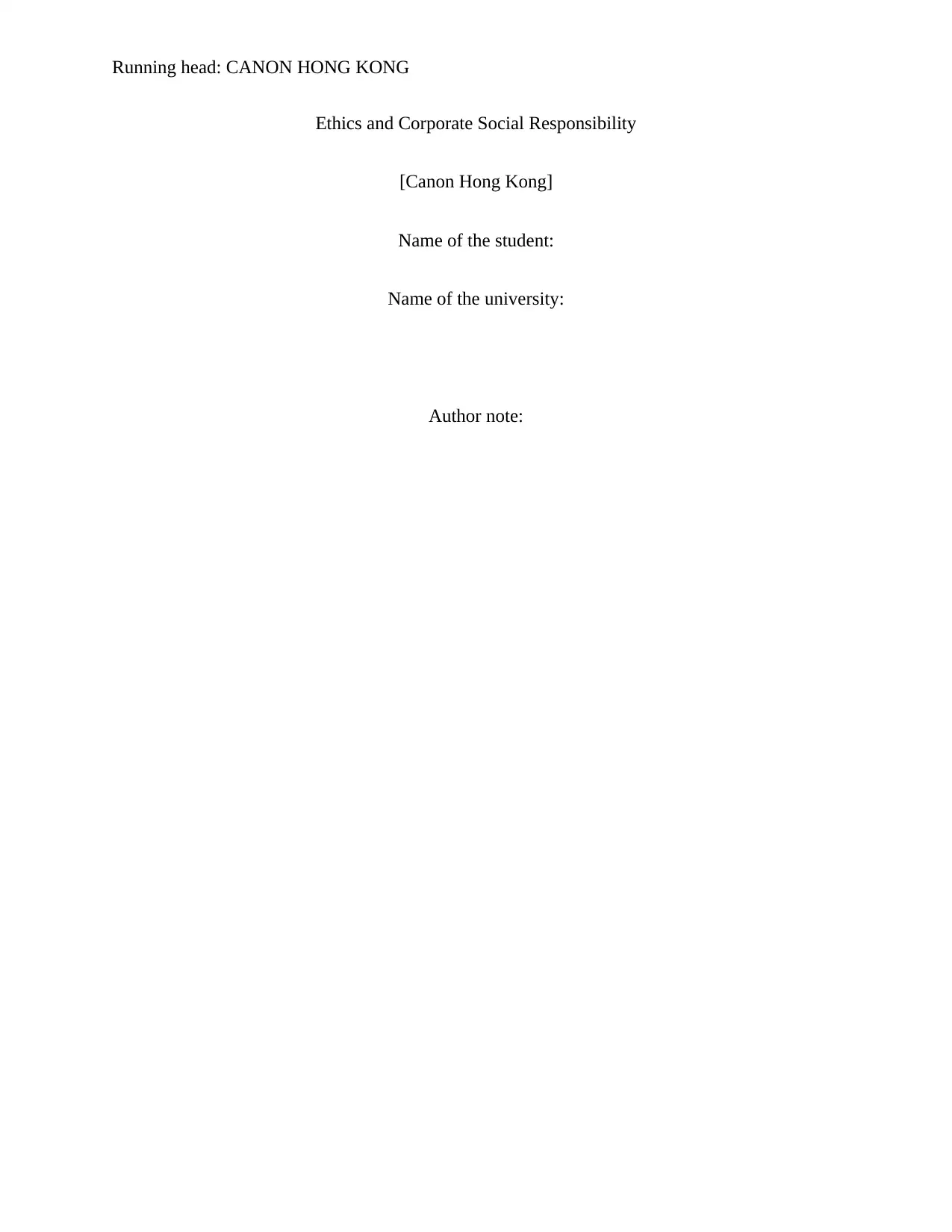
Running head: CANON HONG KONG
Ethics and Corporate Social Responsibility
[Canon Hong Kong]
Name of the student:
Name of the university:
Author note:
Ethics and Corporate Social Responsibility
[Canon Hong Kong]
Name of the student:
Name of the university:
Author note:
Paraphrase This Document
Need a fresh take? Get an instant paraphrase of this document with our AI Paraphraser
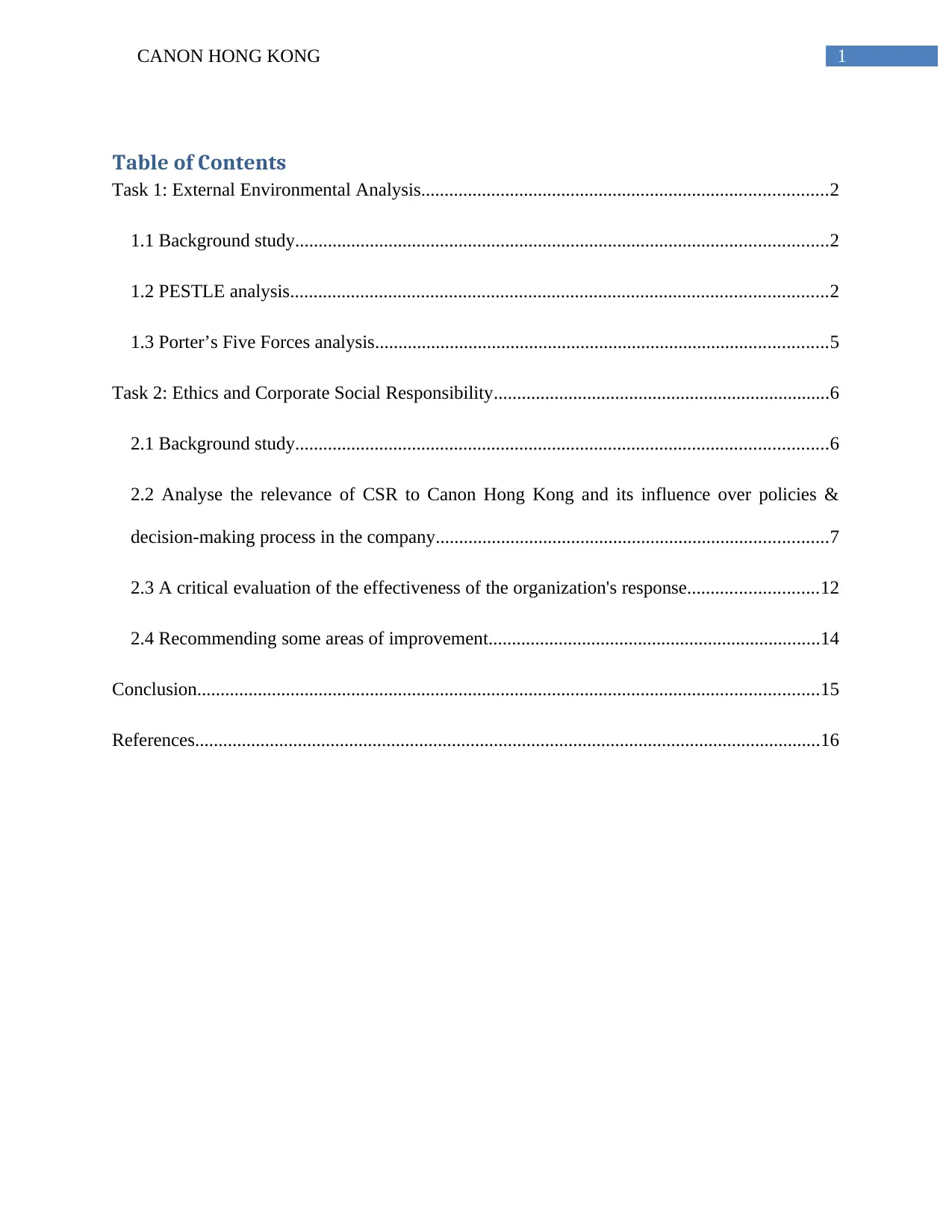
1CANON HONG KONG
Table of Contents
Task 1: External Environmental Analysis.......................................................................................2
1.1 Background study..................................................................................................................2
1.2 PESTLE analysis...................................................................................................................2
1.3 Porter’s Five Forces analysis.................................................................................................5
Task 2: Ethics and Corporate Social Responsibility........................................................................6
2.1 Background study..................................................................................................................6
2.2 Analyse the relevance of CSR to Canon Hong Kong and its influence over policies &
decision-making process in the company....................................................................................7
2.3 A critical evaluation of the effectiveness of the organization's response............................12
2.4 Recommending some areas of improvement.......................................................................14
Conclusion.....................................................................................................................................15
References......................................................................................................................................16
Table of Contents
Task 1: External Environmental Analysis.......................................................................................2
1.1 Background study..................................................................................................................2
1.2 PESTLE analysis...................................................................................................................2
1.3 Porter’s Five Forces analysis.................................................................................................5
Task 2: Ethics and Corporate Social Responsibility........................................................................6
2.1 Background study..................................................................................................................6
2.2 Analyse the relevance of CSR to Canon Hong Kong and its influence over policies &
decision-making process in the company....................................................................................7
2.3 A critical evaluation of the effectiveness of the organization's response............................12
2.4 Recommending some areas of improvement.......................................................................14
Conclusion.....................................................................................................................................15
References......................................................................................................................................16
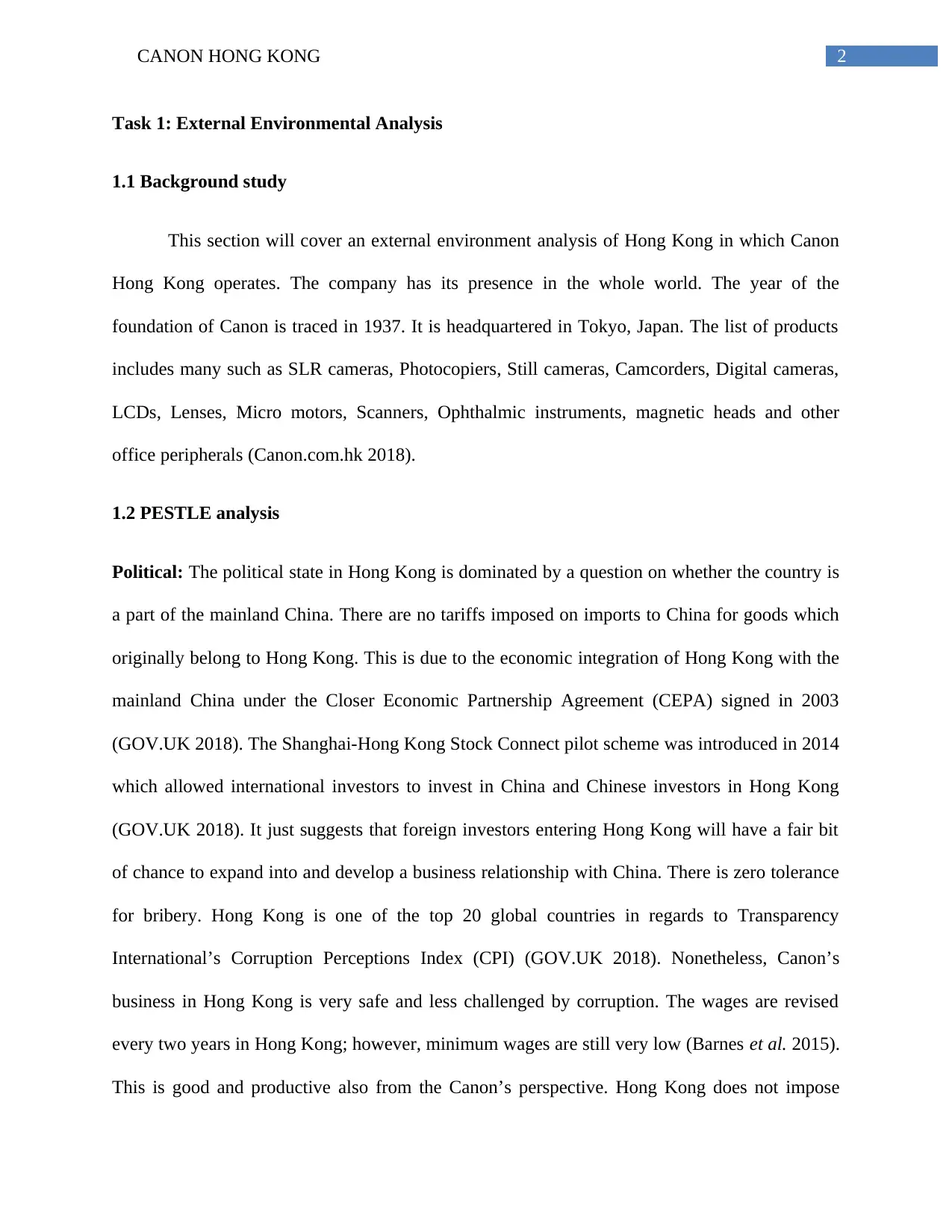
2CANON HONG KONG
Task 1: External Environmental Analysis
1.1 Background study
This section will cover an external environment analysis of Hong Kong in which Canon
Hong Kong operates. The company has its presence in the whole world. The year of the
foundation of Canon is traced in 1937. It is headquartered in Tokyo, Japan. The list of products
includes many such as SLR cameras, Photocopiers, Still cameras, Camcorders, Digital cameras,
LCDs, Lenses, Micro motors, Scanners, Ophthalmic instruments, magnetic heads and other
office peripherals (Canon.com.hk 2018).
1.2 PESTLE analysis
Political: The political state in Hong Kong is dominated by a question on whether the country is
a part of the mainland China. There are no tariffs imposed on imports to China for goods which
originally belong to Hong Kong. This is due to the economic integration of Hong Kong with the
mainland China under the Closer Economic Partnership Agreement (CEPA) signed in 2003
(GOV.UK 2018). The Shanghai-Hong Kong Stock Connect pilot scheme was introduced in 2014
which allowed international investors to invest in China and Chinese investors in Hong Kong
(GOV.UK 2018). It just suggests that foreign investors entering Hong Kong will have a fair bit
of chance to expand into and develop a business relationship with China. There is zero tolerance
for bribery. Hong Kong is one of the top 20 global countries in regards to Transparency
International’s Corruption Perceptions Index (CPI) (GOV.UK 2018). Nonetheless, Canon’s
business in Hong Kong is very safe and less challenged by corruption. The wages are revised
every two years in Hong Kong; however, minimum wages are still very low (Barnes et al. 2015).
This is good and productive also from the Canon’s perspective. Hong Kong does not impose
Task 1: External Environmental Analysis
1.1 Background study
This section will cover an external environment analysis of Hong Kong in which Canon
Hong Kong operates. The company has its presence in the whole world. The year of the
foundation of Canon is traced in 1937. It is headquartered in Tokyo, Japan. The list of products
includes many such as SLR cameras, Photocopiers, Still cameras, Camcorders, Digital cameras,
LCDs, Lenses, Micro motors, Scanners, Ophthalmic instruments, magnetic heads and other
office peripherals (Canon.com.hk 2018).
1.2 PESTLE analysis
Political: The political state in Hong Kong is dominated by a question on whether the country is
a part of the mainland China. There are no tariffs imposed on imports to China for goods which
originally belong to Hong Kong. This is due to the economic integration of Hong Kong with the
mainland China under the Closer Economic Partnership Agreement (CEPA) signed in 2003
(GOV.UK 2018). The Shanghai-Hong Kong Stock Connect pilot scheme was introduced in 2014
which allowed international investors to invest in China and Chinese investors in Hong Kong
(GOV.UK 2018). It just suggests that foreign investors entering Hong Kong will have a fair bit
of chance to expand into and develop a business relationship with China. There is zero tolerance
for bribery. Hong Kong is one of the top 20 global countries in regards to Transparency
International’s Corruption Perceptions Index (CPI) (GOV.UK 2018). Nonetheless, Canon’s
business in Hong Kong is very safe and less challenged by corruption. The wages are revised
every two years in Hong Kong; however, minimum wages are still very low (Barnes et al. 2015).
This is good and productive also from the Canon’s perspective. Hong Kong does not impose
⊘ This is a preview!⊘
Do you want full access?
Subscribe today to unlock all pages.

Trusted by 1+ million students worldwide
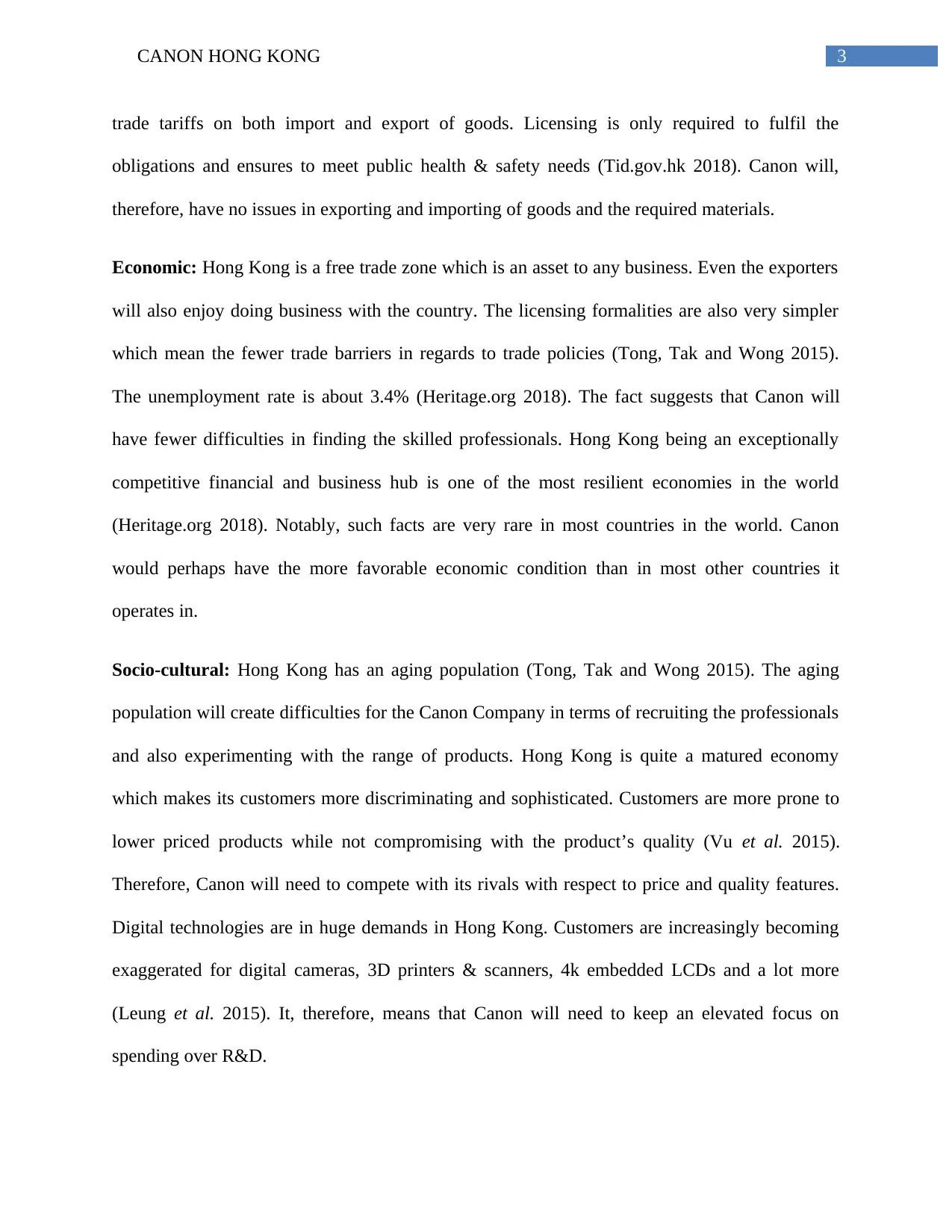
3CANON HONG KONG
trade tariffs on both import and export of goods. Licensing is only required to fulfil the
obligations and ensures to meet public health & safety needs (Tid.gov.hk 2018). Canon will,
therefore, have no issues in exporting and importing of goods and the required materials.
Economic: Hong Kong is a free trade zone which is an asset to any business. Even the exporters
will also enjoy doing business with the country. The licensing formalities are also very simpler
which mean the fewer trade barriers in regards to trade policies (Tong, Tak and Wong 2015).
The unemployment rate is about 3.4% (Heritage.org 2018). The fact suggests that Canon will
have fewer difficulties in finding the skilled professionals. Hong Kong being an exceptionally
competitive financial and business hub is one of the most resilient economies in the world
(Heritage.org 2018). Notably, such facts are very rare in most countries in the world. Canon
would perhaps have the more favorable economic condition than in most other countries it
operates in.
Socio-cultural: Hong Kong has an aging population (Tong, Tak and Wong 2015). The aging
population will create difficulties for the Canon Company in terms of recruiting the professionals
and also experimenting with the range of products. Hong Kong is quite a matured economy
which makes its customers more discriminating and sophisticated. Customers are more prone to
lower priced products while not compromising with the product’s quality (Vu et al. 2015).
Therefore, Canon will need to compete with its rivals with respect to price and quality features.
Digital technologies are in huge demands in Hong Kong. Customers are increasingly becoming
exaggerated for digital cameras, 3D printers & scanners, 4k embedded LCDs and a lot more
(Leung et al. 2015). It, therefore, means that Canon will need to keep an elevated focus on
spending over R&D.
trade tariffs on both import and export of goods. Licensing is only required to fulfil the
obligations and ensures to meet public health & safety needs (Tid.gov.hk 2018). Canon will,
therefore, have no issues in exporting and importing of goods and the required materials.
Economic: Hong Kong is a free trade zone which is an asset to any business. Even the exporters
will also enjoy doing business with the country. The licensing formalities are also very simpler
which mean the fewer trade barriers in regards to trade policies (Tong, Tak and Wong 2015).
The unemployment rate is about 3.4% (Heritage.org 2018). The fact suggests that Canon will
have fewer difficulties in finding the skilled professionals. Hong Kong being an exceptionally
competitive financial and business hub is one of the most resilient economies in the world
(Heritage.org 2018). Notably, such facts are very rare in most countries in the world. Canon
would perhaps have the more favorable economic condition than in most other countries it
operates in.
Socio-cultural: Hong Kong has an aging population (Tong, Tak and Wong 2015). The aging
population will create difficulties for the Canon Company in terms of recruiting the professionals
and also experimenting with the range of products. Hong Kong is quite a matured economy
which makes its customers more discriminating and sophisticated. Customers are more prone to
lower priced products while not compromising with the product’s quality (Vu et al. 2015).
Therefore, Canon will need to compete with its rivals with respect to price and quality features.
Digital technologies are in huge demands in Hong Kong. Customers are increasingly becoming
exaggerated for digital cameras, 3D printers & scanners, 4k embedded LCDs and a lot more
(Leung et al. 2015). It, therefore, means that Canon will need to keep an elevated focus on
spending over R&D.
Paraphrase This Document
Need a fresh take? Get an instant paraphrase of this document with our AI Paraphraser
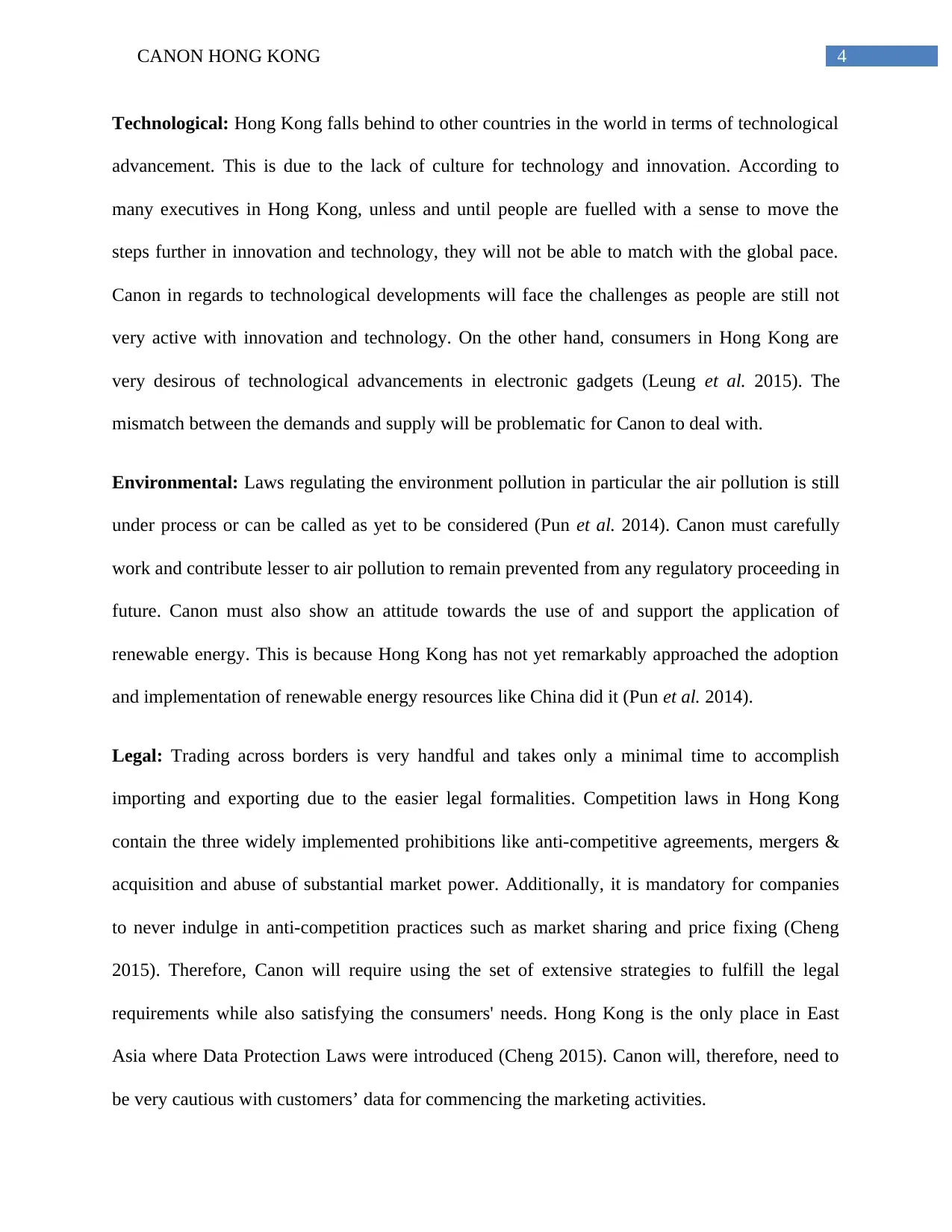
4CANON HONG KONG
Technological: Hong Kong falls behind to other countries in the world in terms of technological
advancement. This is due to the lack of culture for technology and innovation. According to
many executives in Hong Kong, unless and until people are fuelled with a sense to move the
steps further in innovation and technology, they will not be able to match with the global pace.
Canon in regards to technological developments will face the challenges as people are still not
very active with innovation and technology. On the other hand, consumers in Hong Kong are
very desirous of technological advancements in electronic gadgets (Leung et al. 2015). The
mismatch between the demands and supply will be problematic for Canon to deal with.
Environmental: Laws regulating the environment pollution in particular the air pollution is still
under process or can be called as yet to be considered (Pun et al. 2014). Canon must carefully
work and contribute lesser to air pollution to remain prevented from any regulatory proceeding in
future. Canon must also show an attitude towards the use of and support the application of
renewable energy. This is because Hong Kong has not yet remarkably approached the adoption
and implementation of renewable energy resources like China did it (Pun et al. 2014).
Legal: Trading across borders is very handful and takes only a minimal time to accomplish
importing and exporting due to the easier legal formalities. Competition laws in Hong Kong
contain the three widely implemented prohibitions like anti-competitive agreements, mergers &
acquisition and abuse of substantial market power. Additionally, it is mandatory for companies
to never indulge in anti-competition practices such as market sharing and price fixing (Cheng
2015). Therefore, Canon will require using the set of extensive strategies to fulfill the legal
requirements while also satisfying the consumers' needs. Hong Kong is the only place in East
Asia where Data Protection Laws were introduced (Cheng 2015). Canon will, therefore, need to
be very cautious with customers’ data for commencing the marketing activities.
Technological: Hong Kong falls behind to other countries in the world in terms of technological
advancement. This is due to the lack of culture for technology and innovation. According to
many executives in Hong Kong, unless and until people are fuelled with a sense to move the
steps further in innovation and technology, they will not be able to match with the global pace.
Canon in regards to technological developments will face the challenges as people are still not
very active with innovation and technology. On the other hand, consumers in Hong Kong are
very desirous of technological advancements in electronic gadgets (Leung et al. 2015). The
mismatch between the demands and supply will be problematic for Canon to deal with.
Environmental: Laws regulating the environment pollution in particular the air pollution is still
under process or can be called as yet to be considered (Pun et al. 2014). Canon must carefully
work and contribute lesser to air pollution to remain prevented from any regulatory proceeding in
future. Canon must also show an attitude towards the use of and support the application of
renewable energy. This is because Hong Kong has not yet remarkably approached the adoption
and implementation of renewable energy resources like China did it (Pun et al. 2014).
Legal: Trading across borders is very handful and takes only a minimal time to accomplish
importing and exporting due to the easier legal formalities. Competition laws in Hong Kong
contain the three widely implemented prohibitions like anti-competitive agreements, mergers &
acquisition and abuse of substantial market power. Additionally, it is mandatory for companies
to never indulge in anti-competition practices such as market sharing and price fixing (Cheng
2015). Therefore, Canon will require using the set of extensive strategies to fulfill the legal
requirements while also satisfying the consumers' needs. Hong Kong is the only place in East
Asia where Data Protection Laws were introduced (Cheng 2015). Canon will, therefore, need to
be very cautious with customers’ data for commencing the marketing activities.
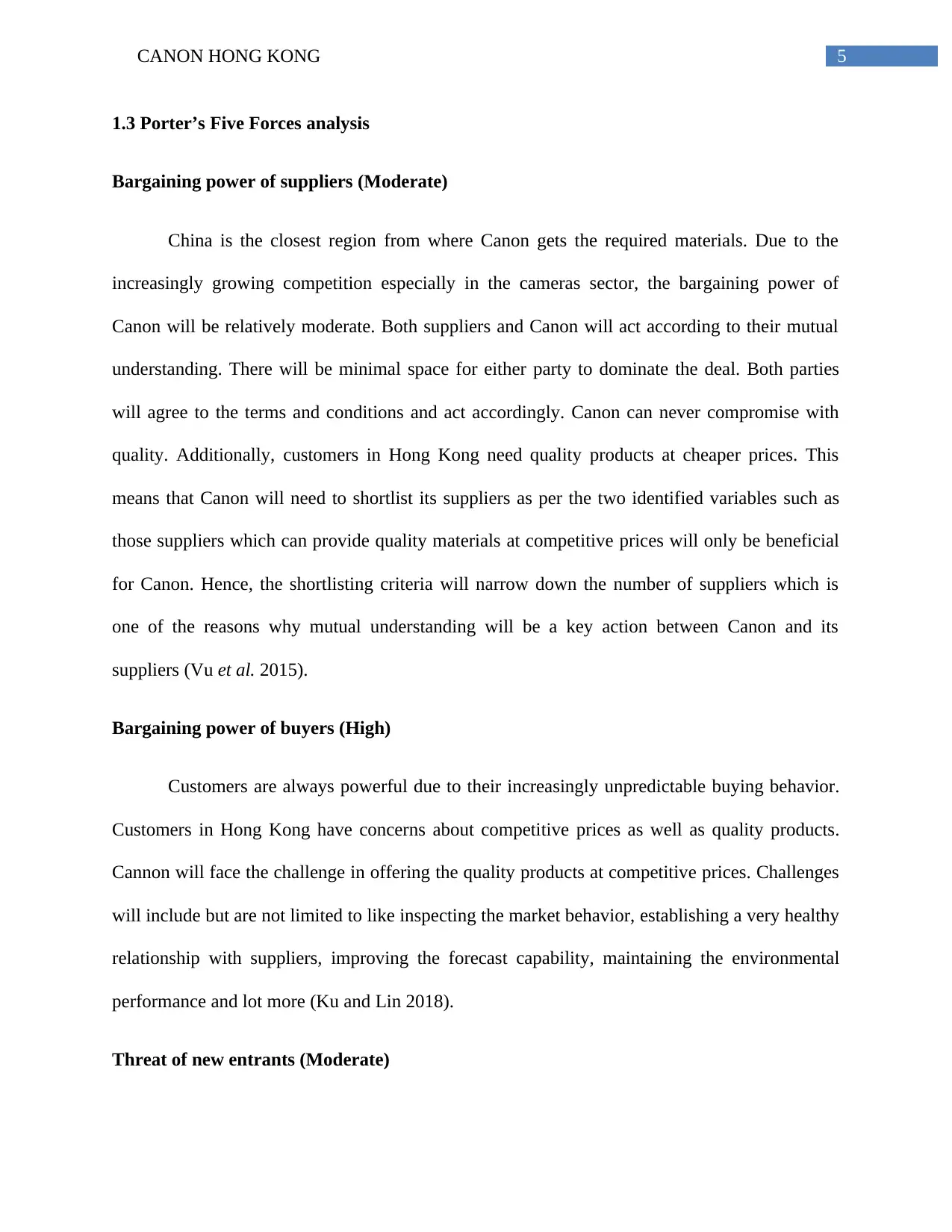
5CANON HONG KONG
1.3 Porter’s Five Forces analysis
Bargaining power of suppliers (Moderate)
China is the closest region from where Canon gets the required materials. Due to the
increasingly growing competition especially in the cameras sector, the bargaining power of
Canon will be relatively moderate. Both suppliers and Canon will act according to their mutual
understanding. There will be minimal space for either party to dominate the deal. Both parties
will agree to the terms and conditions and act accordingly. Canon can never compromise with
quality. Additionally, customers in Hong Kong need quality products at cheaper prices. This
means that Canon will need to shortlist its suppliers as per the two identified variables such as
those suppliers which can provide quality materials at competitive prices will only be beneficial
for Canon. Hence, the shortlisting criteria will narrow down the number of suppliers which is
one of the reasons why mutual understanding will be a key action between Canon and its
suppliers (Vu et al. 2015).
Bargaining power of buyers (High)
Customers are always powerful due to their increasingly unpredictable buying behavior.
Customers in Hong Kong have concerns about competitive prices as well as quality products.
Cannon will face the challenge in offering the quality products at competitive prices. Challenges
will include but are not limited to like inspecting the market behavior, establishing a very healthy
relationship with suppliers, improving the forecast capability, maintaining the environmental
performance and lot more (Ku and Lin 2018).
Threat of new entrants (Moderate)
1.3 Porter’s Five Forces analysis
Bargaining power of suppliers (Moderate)
China is the closest region from where Canon gets the required materials. Due to the
increasingly growing competition especially in the cameras sector, the bargaining power of
Canon will be relatively moderate. Both suppliers and Canon will act according to their mutual
understanding. There will be minimal space for either party to dominate the deal. Both parties
will agree to the terms and conditions and act accordingly. Canon can never compromise with
quality. Additionally, customers in Hong Kong need quality products at cheaper prices. This
means that Canon will need to shortlist its suppliers as per the two identified variables such as
those suppliers which can provide quality materials at competitive prices will only be beneficial
for Canon. Hence, the shortlisting criteria will narrow down the number of suppliers which is
one of the reasons why mutual understanding will be a key action between Canon and its
suppliers (Vu et al. 2015).
Bargaining power of buyers (High)
Customers are always powerful due to their increasingly unpredictable buying behavior.
Customers in Hong Kong have concerns about competitive prices as well as quality products.
Cannon will face the challenge in offering the quality products at competitive prices. Challenges
will include but are not limited to like inspecting the market behavior, establishing a very healthy
relationship with suppliers, improving the forecast capability, maintaining the environmental
performance and lot more (Ku and Lin 2018).
Threat of new entrants (Moderate)
⊘ This is a preview!⊘
Do you want full access?
Subscribe today to unlock all pages.

Trusted by 1+ million students worldwide
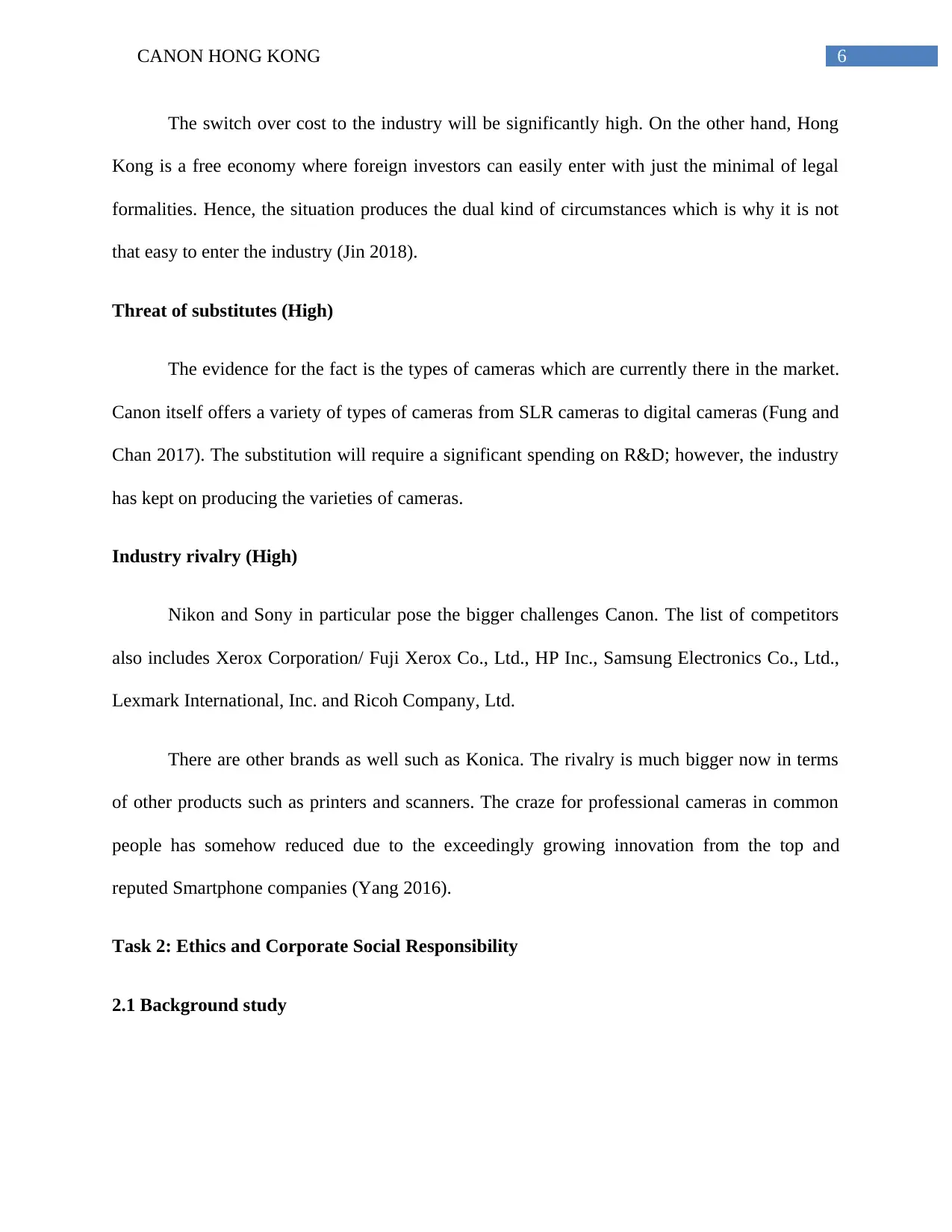
6CANON HONG KONG
The switch over cost to the industry will be significantly high. On the other hand, Hong
Kong is a free economy where foreign investors can easily enter with just the minimal of legal
formalities. Hence, the situation produces the dual kind of circumstances which is why it is not
that easy to enter the industry (Jin 2018).
Threat of substitutes (High)
The evidence for the fact is the types of cameras which are currently there in the market.
Canon itself offers a variety of types of cameras from SLR cameras to digital cameras (Fung and
Chan 2017). The substitution will require a significant spending on R&D; however, the industry
has kept on producing the varieties of cameras.
Industry rivalry (High)
Nikon and Sony in particular pose the bigger challenges Canon. The list of competitors
also includes Xerox Corporation/ Fuji Xerox Co., Ltd., HP Inc., Samsung Electronics Co., Ltd.,
Lexmark International, Inc. and Ricoh Company, Ltd.
There are other brands as well such as Konica. The rivalry is much bigger now in terms
of other products such as printers and scanners. The craze for professional cameras in common
people has somehow reduced due to the exceedingly growing innovation from the top and
reputed Smartphone companies (Yang 2016).
Task 2: Ethics and Corporate Social Responsibility
2.1 Background study
The switch over cost to the industry will be significantly high. On the other hand, Hong
Kong is a free economy where foreign investors can easily enter with just the minimal of legal
formalities. Hence, the situation produces the dual kind of circumstances which is why it is not
that easy to enter the industry (Jin 2018).
Threat of substitutes (High)
The evidence for the fact is the types of cameras which are currently there in the market.
Canon itself offers a variety of types of cameras from SLR cameras to digital cameras (Fung and
Chan 2017). The substitution will require a significant spending on R&D; however, the industry
has kept on producing the varieties of cameras.
Industry rivalry (High)
Nikon and Sony in particular pose the bigger challenges Canon. The list of competitors
also includes Xerox Corporation/ Fuji Xerox Co., Ltd., HP Inc., Samsung Electronics Co., Ltd.,
Lexmark International, Inc. and Ricoh Company, Ltd.
There are other brands as well such as Konica. The rivalry is much bigger now in terms
of other products such as printers and scanners. The craze for professional cameras in common
people has somehow reduced due to the exceedingly growing innovation from the top and
reputed Smartphone companies (Yang 2016).
Task 2: Ethics and Corporate Social Responsibility
2.1 Background study
Paraphrase This Document
Need a fresh take? Get an instant paraphrase of this document with our AI Paraphraser
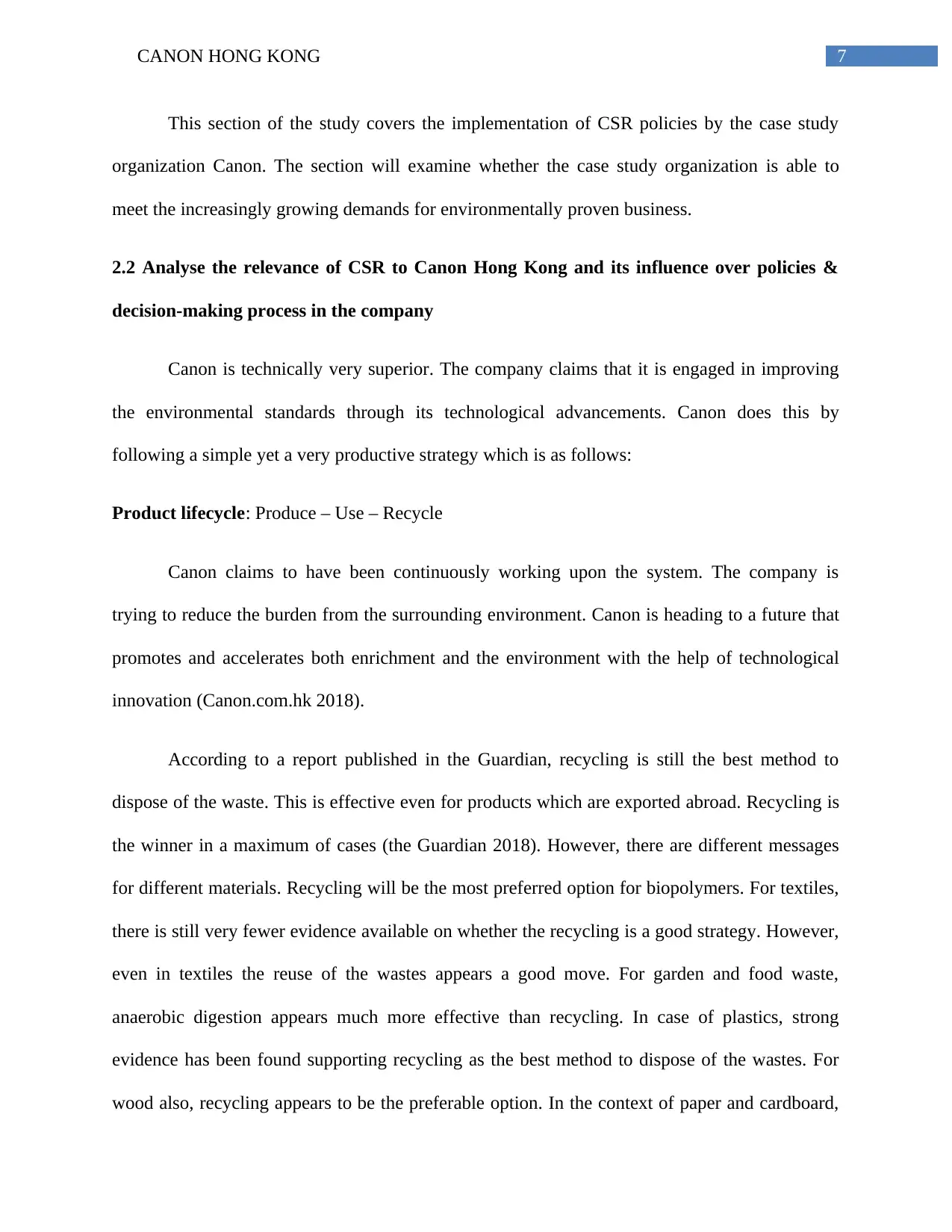
7CANON HONG KONG
This section of the study covers the implementation of CSR policies by the case study
organization Canon. The section will examine whether the case study organization is able to
meet the increasingly growing demands for environmentally proven business.
2.2 Analyse the relevance of CSR to Canon Hong Kong and its influence over policies &
decision-making process in the company
Canon is technically very superior. The company claims that it is engaged in improving
the environmental standards through its technological advancements. Canon does this by
following a simple yet a very productive strategy which is as follows:
Product lifecycle: Produce – Use – Recycle
Canon claims to have been continuously working upon the system. The company is
trying to reduce the burden from the surrounding environment. Canon is heading to a future that
promotes and accelerates both enrichment and the environment with the help of technological
innovation (Canon.com.hk 2018).
According to a report published in the Guardian, recycling is still the best method to
dispose of the waste. This is effective even for products which are exported abroad. Recycling is
the winner in a maximum of cases (the Guardian 2018). However, there are different messages
for different materials. Recycling will be the most preferred option for biopolymers. For textiles,
there is still very fewer evidence available on whether the recycling is a good strategy. However,
even in textiles the reuse of the wastes appears a good move. For garden and food waste,
anaerobic digestion appears much more effective than recycling. In case of plastics, strong
evidence has been found supporting recycling as the best method to dispose of the wastes. For
wood also, recycling appears to be the preferable option. In the context of paper and cardboard,
This section of the study covers the implementation of CSR policies by the case study
organization Canon. The section will examine whether the case study organization is able to
meet the increasingly growing demands for environmentally proven business.
2.2 Analyse the relevance of CSR to Canon Hong Kong and its influence over policies &
decision-making process in the company
Canon is technically very superior. The company claims that it is engaged in improving
the environmental standards through its technological advancements. Canon does this by
following a simple yet a very productive strategy which is as follows:
Product lifecycle: Produce – Use – Recycle
Canon claims to have been continuously working upon the system. The company is
trying to reduce the burden from the surrounding environment. Canon is heading to a future that
promotes and accelerates both enrichment and the environment with the help of technological
innovation (Canon.com.hk 2018).
According to a report published in the Guardian, recycling is still the best method to
dispose of the waste. This is effective even for products which are exported abroad. Recycling is
the winner in a maximum of cases (the Guardian 2018). However, there are different messages
for different materials. Recycling will be the most preferred option for biopolymers. For textiles,
there is still very fewer evidence available on whether the recycling is a good strategy. However,
even in textiles the reuse of the wastes appears a good move. For garden and food waste,
anaerobic digestion appears much more effective than recycling. In case of plastics, strong
evidence has been found supporting recycling as the best method to dispose of the wastes. For
wood also, recycling appears to be the preferable option. In the context of paper and cardboard,
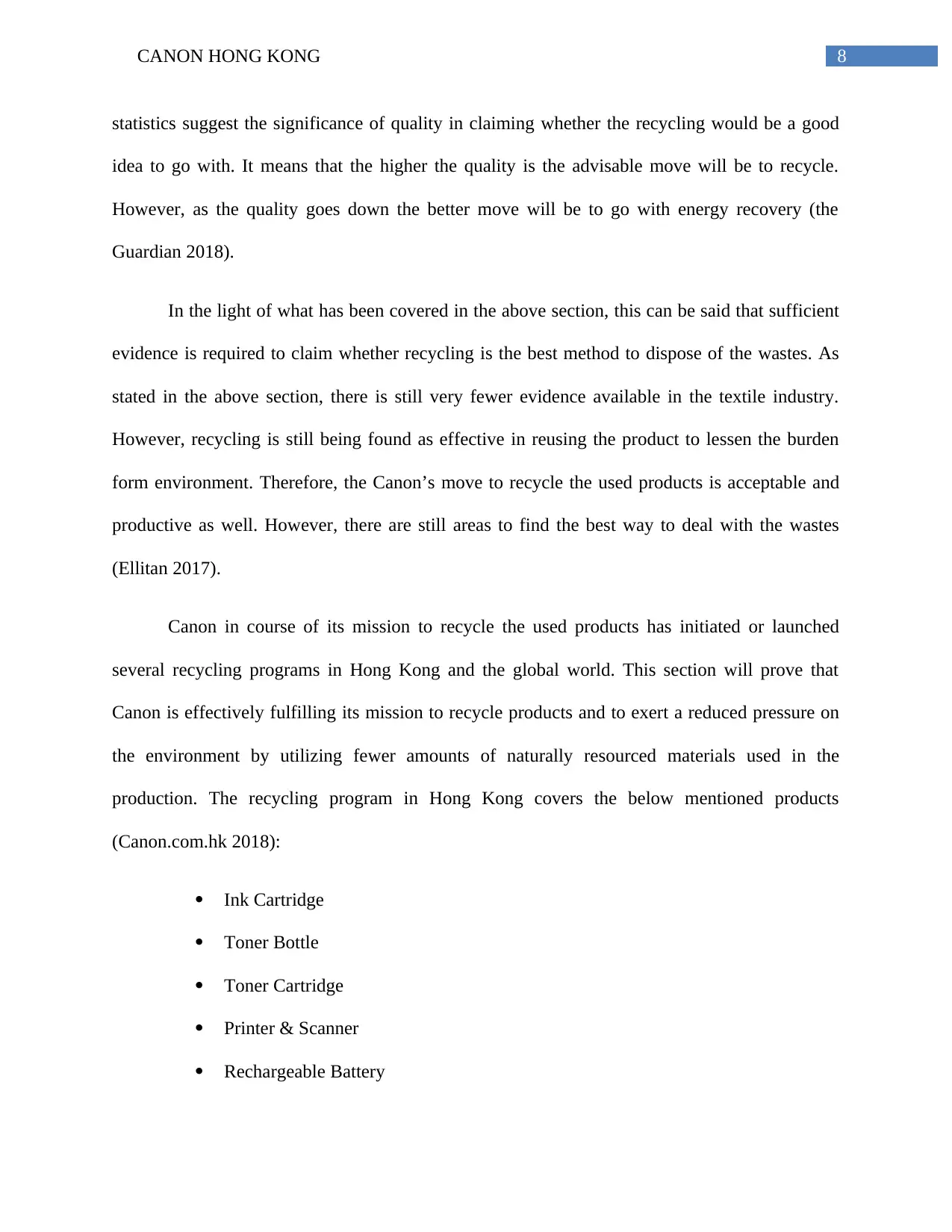
8CANON HONG KONG
statistics suggest the significance of quality in claiming whether the recycling would be a good
idea to go with. It means that the higher the quality is the advisable move will be to recycle.
However, as the quality goes down the better move will be to go with energy recovery (the
Guardian 2018).
In the light of what has been covered in the above section, this can be said that sufficient
evidence is required to claim whether recycling is the best method to dispose of the wastes. As
stated in the above section, there is still very fewer evidence available in the textile industry.
However, recycling is still being found as effective in reusing the product to lessen the burden
form environment. Therefore, the Canon’s move to recycle the used products is acceptable and
productive as well. However, there are still areas to find the best way to deal with the wastes
(Ellitan 2017).
Canon in course of its mission to recycle the used products has initiated or launched
several recycling programs in Hong Kong and the global world. This section will prove that
Canon is effectively fulfilling its mission to recycle products and to exert a reduced pressure on
the environment by utilizing fewer amounts of naturally resourced materials used in the
production. The recycling program in Hong Kong covers the below mentioned products
(Canon.com.hk 2018):
Ink Cartridge
Toner Bottle
Toner Cartridge
Printer & Scanner
Rechargeable Battery
statistics suggest the significance of quality in claiming whether the recycling would be a good
idea to go with. It means that the higher the quality is the advisable move will be to recycle.
However, as the quality goes down the better move will be to go with energy recovery (the
Guardian 2018).
In the light of what has been covered in the above section, this can be said that sufficient
evidence is required to claim whether recycling is the best method to dispose of the wastes. As
stated in the above section, there is still very fewer evidence available in the textile industry.
However, recycling is still being found as effective in reusing the product to lessen the burden
form environment. Therefore, the Canon’s move to recycle the used products is acceptable and
productive as well. However, there are still areas to find the best way to deal with the wastes
(Ellitan 2017).
Canon in course of its mission to recycle the used products has initiated or launched
several recycling programs in Hong Kong and the global world. This section will prove that
Canon is effectively fulfilling its mission to recycle products and to exert a reduced pressure on
the environment by utilizing fewer amounts of naturally resourced materials used in the
production. The recycling program in Hong Kong covers the below mentioned products
(Canon.com.hk 2018):
Ink Cartridge
Toner Bottle
Toner Cartridge
Printer & Scanner
Rechargeable Battery
⊘ This is a preview!⊘
Do you want full access?
Subscribe today to unlock all pages.

Trusted by 1+ million students worldwide
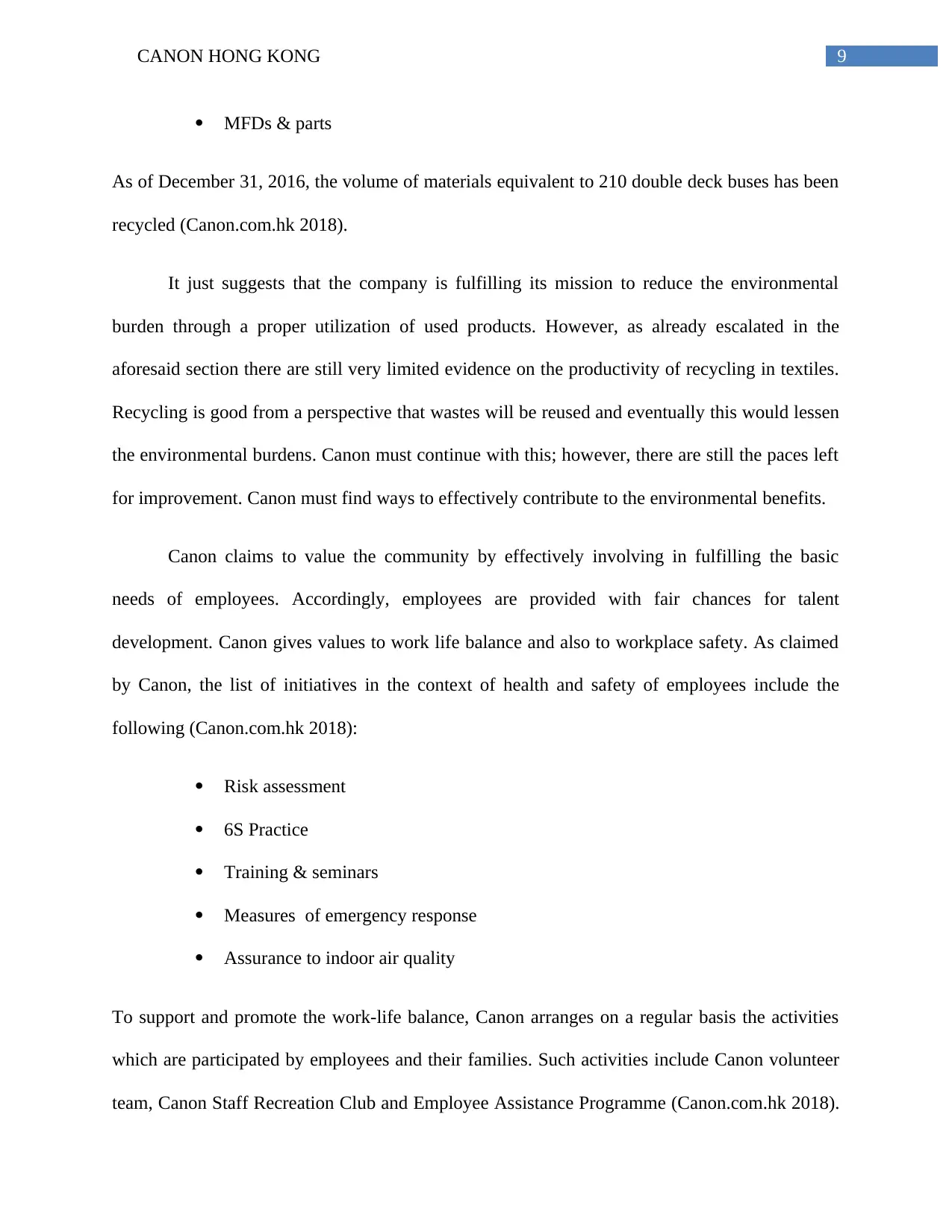
9CANON HONG KONG
MFDs & parts
As of December 31, 2016, the volume of materials equivalent to 210 double deck buses has been
recycled (Canon.com.hk 2018).
It just suggests that the company is fulfilling its mission to reduce the environmental
burden through a proper utilization of used products. However, as already escalated in the
aforesaid section there are still very limited evidence on the productivity of recycling in textiles.
Recycling is good from a perspective that wastes will be reused and eventually this would lessen
the environmental burdens. Canon must continue with this; however, there are still the paces left
for improvement. Canon must find ways to effectively contribute to the environmental benefits.
Canon claims to value the community by effectively involving in fulfilling the basic
needs of employees. Accordingly, employees are provided with fair chances for talent
development. Canon gives values to work life balance and also to workplace safety. As claimed
by Canon, the list of initiatives in the context of health and safety of employees include the
following (Canon.com.hk 2018):
Risk assessment
6S Practice
Training & seminars
Measures of emergency response
Assurance to indoor air quality
To support and promote the work-life balance, Canon arranges on a regular basis the activities
which are participated by employees and their families. Such activities include Canon volunteer
team, Canon Staff Recreation Club and Employee Assistance Programme (Canon.com.hk 2018).
MFDs & parts
As of December 31, 2016, the volume of materials equivalent to 210 double deck buses has been
recycled (Canon.com.hk 2018).
It just suggests that the company is fulfilling its mission to reduce the environmental
burden through a proper utilization of used products. However, as already escalated in the
aforesaid section there are still very limited evidence on the productivity of recycling in textiles.
Recycling is good from a perspective that wastes will be reused and eventually this would lessen
the environmental burdens. Canon must continue with this; however, there are still the paces left
for improvement. Canon must find ways to effectively contribute to the environmental benefits.
Canon claims to value the community by effectively involving in fulfilling the basic
needs of employees. Accordingly, employees are provided with fair chances for talent
development. Canon gives values to work life balance and also to workplace safety. As claimed
by Canon, the list of initiatives in the context of health and safety of employees include the
following (Canon.com.hk 2018):
Risk assessment
6S Practice
Training & seminars
Measures of emergency response
Assurance to indoor air quality
To support and promote the work-life balance, Canon arranges on a regular basis the activities
which are participated by employees and their families. Such activities include Canon volunteer
team, Canon Staff Recreation Club and Employee Assistance Programme (Canon.com.hk 2018).
Paraphrase This Document
Need a fresh take? Get an instant paraphrase of this document with our AI Paraphraser
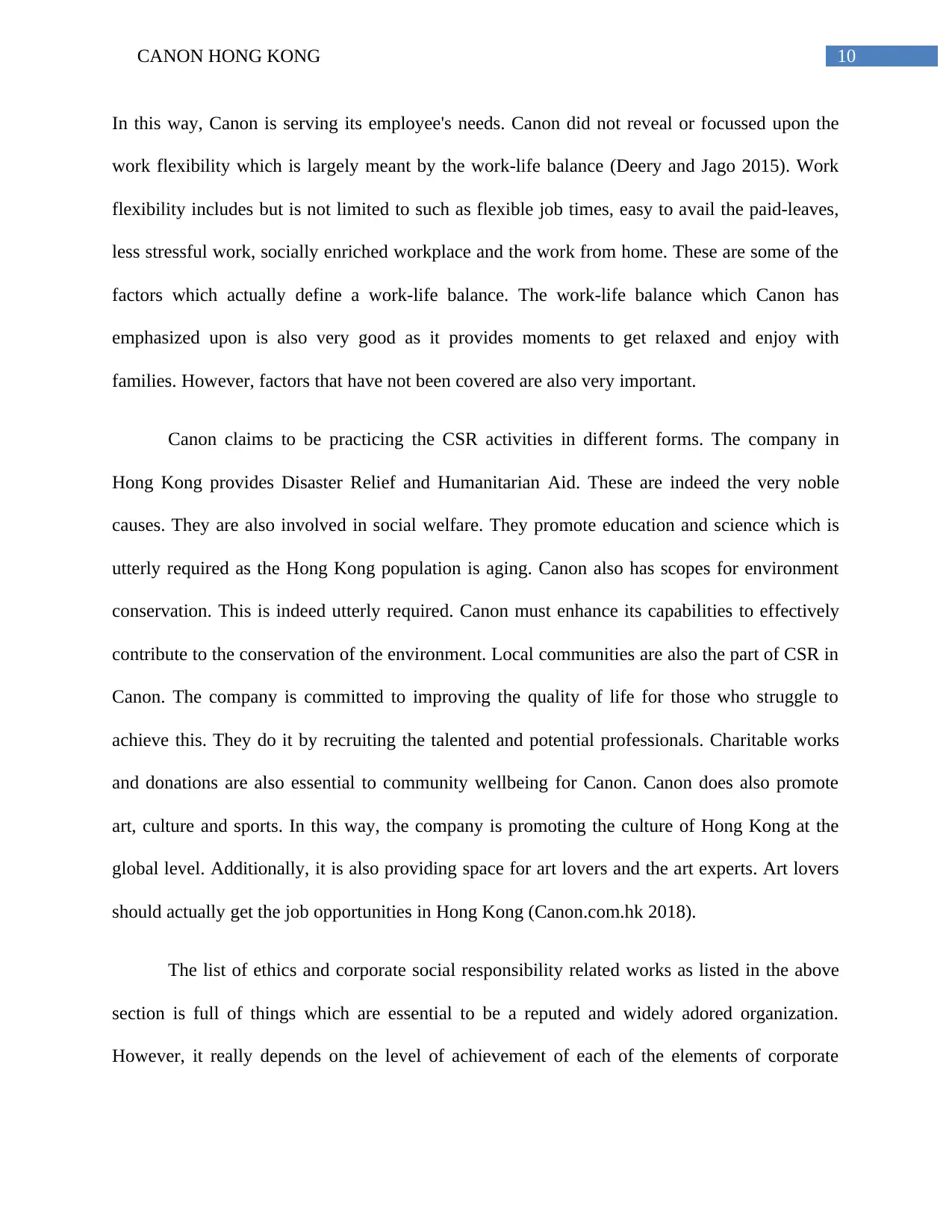
10CANON HONG KONG
In this way, Canon is serving its employee's needs. Canon did not reveal or focussed upon the
work flexibility which is largely meant by the work-life balance (Deery and Jago 2015). Work
flexibility includes but is not limited to such as flexible job times, easy to avail the paid-leaves,
less stressful work, socially enriched workplace and the work from home. These are some of the
factors which actually define a work-life balance. The work-life balance which Canon has
emphasized upon is also very good as it provides moments to get relaxed and enjoy with
families. However, factors that have not been covered are also very important.
Canon claims to be practicing the CSR activities in different forms. The company in
Hong Kong provides Disaster Relief and Humanitarian Aid. These are indeed the very noble
causes. They are also involved in social welfare. They promote education and science which is
utterly required as the Hong Kong population is aging. Canon also has scopes for environment
conservation. This is indeed utterly required. Canon must enhance its capabilities to effectively
contribute to the conservation of the environment. Local communities are also the part of CSR in
Canon. The company is committed to improving the quality of life for those who struggle to
achieve this. They do it by recruiting the talented and potential professionals. Charitable works
and donations are also essential to community wellbeing for Canon. Canon does also promote
art, culture and sports. In this way, the company is promoting the culture of Hong Kong at the
global level. Additionally, it is also providing space for art lovers and the art experts. Art lovers
should actually get the job opportunities in Hong Kong (Canon.com.hk 2018).
The list of ethics and corporate social responsibility related works as listed in the above
section is full of things which are essential to be a reputed and widely adored organization.
However, it really depends on the level of achievement of each of the elements of corporate
In this way, Canon is serving its employee's needs. Canon did not reveal or focussed upon the
work flexibility which is largely meant by the work-life balance (Deery and Jago 2015). Work
flexibility includes but is not limited to such as flexible job times, easy to avail the paid-leaves,
less stressful work, socially enriched workplace and the work from home. These are some of the
factors which actually define a work-life balance. The work-life balance which Canon has
emphasized upon is also very good as it provides moments to get relaxed and enjoy with
families. However, factors that have not been covered are also very important.
Canon claims to be practicing the CSR activities in different forms. The company in
Hong Kong provides Disaster Relief and Humanitarian Aid. These are indeed the very noble
causes. They are also involved in social welfare. They promote education and science which is
utterly required as the Hong Kong population is aging. Canon also has scopes for environment
conservation. This is indeed utterly required. Canon must enhance its capabilities to effectively
contribute to the conservation of the environment. Local communities are also the part of CSR in
Canon. The company is committed to improving the quality of life for those who struggle to
achieve this. They do it by recruiting the talented and potential professionals. Charitable works
and donations are also essential to community wellbeing for Canon. Canon does also promote
art, culture and sports. In this way, the company is promoting the culture of Hong Kong at the
global level. Additionally, it is also providing space for art lovers and the art experts. Art lovers
should actually get the job opportunities in Hong Kong (Canon.com.hk 2018).
The list of ethics and corporate social responsibility related works as listed in the above
section is full of things which are essential to be a reputed and widely adored organization.
However, it really depends on the level of achievement of each of the elements of corporate
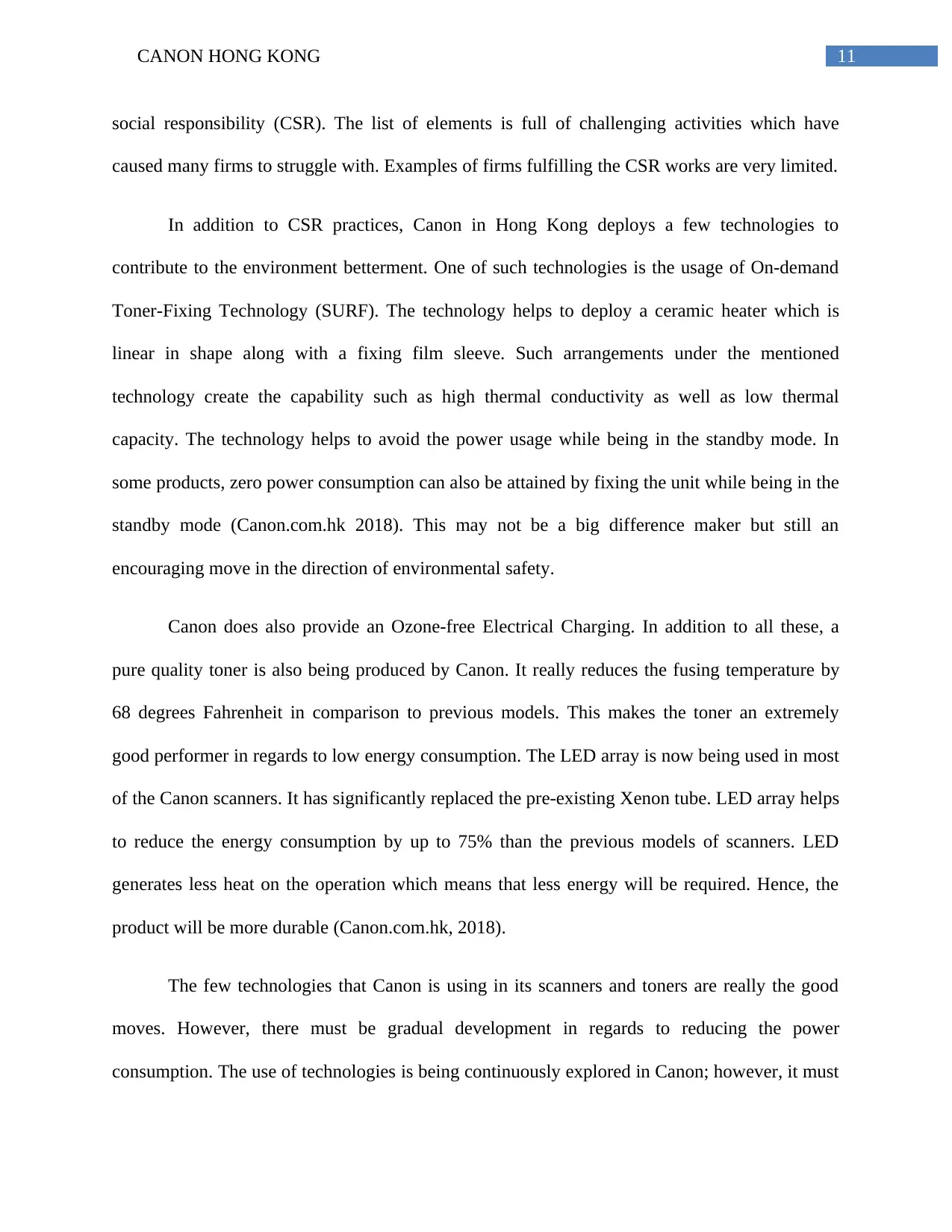
11CANON HONG KONG
social responsibility (CSR). The list of elements is full of challenging activities which have
caused many firms to struggle with. Examples of firms fulfilling the CSR works are very limited.
In addition to CSR practices, Canon in Hong Kong deploys a few technologies to
contribute to the environment betterment. One of such technologies is the usage of On-demand
Toner-Fixing Technology (SURF). The technology helps to deploy a ceramic heater which is
linear in shape along with a fixing film sleeve. Such arrangements under the mentioned
technology create the capability such as high thermal conductivity as well as low thermal
capacity. The technology helps to avoid the power usage while being in the standby mode. In
some products, zero power consumption can also be attained by fixing the unit while being in the
standby mode (Canon.com.hk 2018). This may not be a big difference maker but still an
encouraging move in the direction of environmental safety.
Canon does also provide an Ozone-free Electrical Charging. In addition to all these, a
pure quality toner is also being produced by Canon. It really reduces the fusing temperature by
68 degrees Fahrenheit in comparison to previous models. This makes the toner an extremely
good performer in regards to low energy consumption. The LED array is now being used in most
of the Canon scanners. It has significantly replaced the pre-existing Xenon tube. LED array helps
to reduce the energy consumption by up to 75% than the previous models of scanners. LED
generates less heat on the operation which means that less energy will be required. Hence, the
product will be more durable (Canon.com.hk, 2018).
The few technologies that Canon is using in its scanners and toners are really the good
moves. However, there must be gradual development in regards to reducing the power
consumption. The use of technologies is being continuously explored in Canon; however, it must
social responsibility (CSR). The list of elements is full of challenging activities which have
caused many firms to struggle with. Examples of firms fulfilling the CSR works are very limited.
In addition to CSR practices, Canon in Hong Kong deploys a few technologies to
contribute to the environment betterment. One of such technologies is the usage of On-demand
Toner-Fixing Technology (SURF). The technology helps to deploy a ceramic heater which is
linear in shape along with a fixing film sleeve. Such arrangements under the mentioned
technology create the capability such as high thermal conductivity as well as low thermal
capacity. The technology helps to avoid the power usage while being in the standby mode. In
some products, zero power consumption can also be attained by fixing the unit while being in the
standby mode (Canon.com.hk 2018). This may not be a big difference maker but still an
encouraging move in the direction of environmental safety.
Canon does also provide an Ozone-free Electrical Charging. In addition to all these, a
pure quality toner is also being produced by Canon. It really reduces the fusing temperature by
68 degrees Fahrenheit in comparison to previous models. This makes the toner an extremely
good performer in regards to low energy consumption. The LED array is now being used in most
of the Canon scanners. It has significantly replaced the pre-existing Xenon tube. LED array helps
to reduce the energy consumption by up to 75% than the previous models of scanners. LED
generates less heat on the operation which means that less energy will be required. Hence, the
product will be more durable (Canon.com.hk, 2018).
The few technologies that Canon is using in its scanners and toners are really the good
moves. However, there must be gradual development in regards to reducing the power
consumption. The use of technologies is being continuously explored in Canon; however, it must
⊘ This is a preview!⊘
Do you want full access?
Subscribe today to unlock all pages.

Trusted by 1+ million students worldwide
1 out of 20
Related Documents
Your All-in-One AI-Powered Toolkit for Academic Success.
+13062052269
info@desklib.com
Available 24*7 on WhatsApp / Email
![[object Object]](/_next/static/media/star-bottom.7253800d.svg)
Unlock your academic potential
Copyright © 2020–2025 A2Z Services. All Rights Reserved. Developed and managed by ZUCOL.




